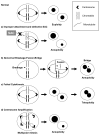Viral transformation and aneuploidy
- PMID: 19326462
- PMCID: PMC2760603
- DOI: 10.1002/em.20480
Viral transformation and aneuploidy
Abstract
Human tumor viruses are associated with a variety of human malignancies, and it is estimated that 15% of all human cancers have a viral etiology. An abnormality in chromosomal ploidy or aneuploidy is a hallmark of cancers. In normal cells, euploidy is governed by several factors including an intact spindle assembly checkpoint, accurate centrosome duplication, and proper cytokinesis. Viral oncoproteins are suggested to perturb the cellular machineries for chromosomal segregation creating aneuploidy which can lead to the malignant transformation of infected cells. Here, we review in brief some of the mechanisms used by viruses that can cause cellular aneuploidy.
(c) 2009 Wiley-Liss, Inc.
Figures


Similar articles
-
Aneuploidy and oncoviruses.Rev Med Virol. 2019 Nov;29(6):e2076. doi: 10.1002/rmv.2076. Epub 2019 Aug 12. Rev Med Virol. 2019. PMID: 31407416 Review.
-
Aneuploidy and cancer.J Cell Biochem. 2007 Oct 15;102(3):531-8. doi: 10.1002/jcb.21484. J Cell Biochem. 2007. PMID: 17661351 Review.
-
Mitotic kinases: the key to duplication, segregation, and cytokinesis errors, chromosomal instability, and oncogenesis.Pharmacol Ther. 2006 Sep;111(3):974-84. doi: 10.1016/j.pharmthera.2006.02.006. Epub 2006 Apr 17. Pharmacol Ther. 2006. PMID: 16603252 Review.
-
The DNA damage response in viral-induced cellular transformation.Br J Cancer. 2012 Jan 31;106(3):429-35. doi: 10.1038/bjc.2011.612. Epub 2012 Jan 12. Br J Cancer. 2012. PMID: 22240795 Free PMC article. Review.
-
Viral carcinogenesis and genomic instability.EXS. 2006;(96):179-99. doi: 10.1007/3-7643-7378-4_8. EXS. 2006. PMID: 16383019 Review.
Cited by
-
Molecular mechanisms of HTLV-1 infection and pathogenesis.Int J Hematol. 2011 Nov;94(5):435-42. doi: 10.1007/s12185-011-0937-1. Epub 2011 Sep 28. Int J Hematol. 2011. PMID: 21953273 Review.
-
Modes of Human T Cell Leukemia Virus Type 1 Transmission, Replication and Persistence.Viruses. 2015 Jul 7;7(7):3603-24. doi: 10.3390/v7072793. Viruses. 2015. PMID: 26198240 Free PMC article. Review.
-
Polyploid Giant Cancer Cells, a Hallmark of Oncoviruses and a New Therapeutic Challenge.Front Oncol. 2020 Oct 14;10:567116. doi: 10.3389/fonc.2020.567116. eCollection 2020. Front Oncol. 2020. PMID: 33154944 Free PMC article. Review.
-
Sero-Prevalence of Bloodborne Tumor Viruses (HCV, HBV, HTLV-I and KSHV Infections) and Related Risk Factors among Prisoners in Razavi Khorasan Province, Iran, in 2008.Hepat Mon. 2016 Dec 3;16(12):e31541. doi: 10.5812/hepatmon.31541. eCollection 2016 Dec. Hepat Mon. 2016. PMID: 28123439 Free PMC article.
-
Oncogenic spiral by infectious pathogens: Cooperation of multiple factors in cancer development.Cancer Sci. 2018 Jan;109(1):24-32. doi: 10.1111/cas.13443. Epub 2017 Dec 3. Cancer Sci. 2018. PMID: 29143406 Free PMC article. Review.
References
-
- Arima N, Kao CY, Licht T, Padmanabhan R, Sasaguri Y, Padmanabhan R. Modulation of cell growth by the hepatitis C virus nonstructural protein NS5A. J Biol Chem. 2001;276:12675–12684. - PubMed
-
- Baek KH, Park HY, Kang CM, Kim SJ, Jeong SJ, Hong EK, Park JW, Sung YC, Suzuki T, Kim CM, Lee CW. Overexpression of hepatitis C virus NS5A protein induces chromosome instability via mitotic cell cycle dysregulation. J Mol Biol. 2006;359:22–34. - PubMed
Publication types
MeSH terms
Grants and funding
LinkOut - more resources
Full Text Sources

